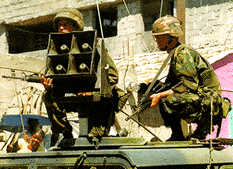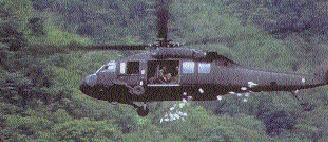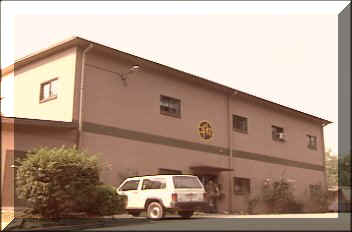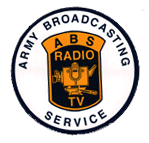 Return
to the Clandestine
Radio Intel
Return
to the Clandestine
Radio Intel

Investigative
Report:
Radio
and U.S. Military Psypos
By Nick Grace C., February
11, 1998
[ Vietnam
War ] [ Grenada
] [ Panama
] [ Gulf
War ] [ Somalia
] [ Haiti
] [ Bosnia
] [ Iraq
]
[ Army Field
Manual on Radio PSYOPS ]

|

|
|
PSYOPS Troops using loudspeakers to blare
warning messages for Haitian citizens in 1994.
|
PSYOPS troops airdropping leaflets.
|
Clandestine radio is an extremely effective form
of propaganda that oftentimes supports military operations. Along
with other tactics, including the dropping of leaflets and the use of loudspeakers,
radio can "win the hearts and minds" of the target audience and has, in
the past, won compliance from hostile leaders. Although clandestine
radio broadcasts are generally associated with intelligence agencies and
guerilla groups, the U.S. Army has long used it for PSYPOS - Psychological
Operations.
PSYOPS, according to Chuck Payne, is "the dissemination
of truthful information to foreign audiences in support of U.S. policy
and national objectives." As a form of nonviolent force, it relies
on "logic, fear, desire or other mental factors to promote specific emotions,
attitudes or behaviors" through persuasion. And these attitudes and
behaviors that are promoted "can range from gaining support for U.S. operations
to preparing the battlefield for combat" (Payne). The U.S. military
considers successful PSYOPS to be a "force multiplier," that is, the maximum
non-violent resource capability to fulfill force protection during operations.
"Psywarrior," a U.S. Army veteran, has posted
a superb webpage that covers all of the aspects of PSYOPS. For more
information, his site is highly suggested: http://www.geocities.com/Pentagon/1012/.

|

|
|
The Army's Armed Forces Radio Service began
as mobile clandestine radio stations during the Korean War.
|
These clandestine stations became the American
Forces Network Korea (AFKN) that continues to broadcast on AM, FM and TV.
|
Radio and psychological war developed from the
success of propaganda during World War II. The U.S. Army Far East
Command quickly seized upon the idea and broadcast programs to South Korea
in 1950 following the North Korea's cross of the 38th Parallel (Psywarrior,
"History"). A radio station was set up in the destroyed American
embassy in Seoul on October 4, 1950 that began with General Douglas MacArthur's
demand that Kim Il-Sung, the chief of the North Korean troops, surrender.
As battle lines changed and the Korean War developed, the station broadcast
from mobile trucks and had many names: Radio Kilroy,
Radio Vagabond, Radio
Comet and Radio Mercury (AFKN Webpage).
AFKN finally found its home in the building pictured above and has been
broadcasting to U.S. troops stationed in South Korea as part of the Army
Broadcasting Service since the conclusion of hostilities. Following
the success of radio during war, the Army produced a Field Manual entitled
"Psychological Warfare Operations (FM 33-5)" in 1955 that discussed the
importance of radio broadcasts to support U.S. military operations.
Vietnam War
The 1960's and the Vietnam War are considered
to be when radio and Psyops truly converged. President Kennedy was
a believer in "unconventional war," that is guerilla war, and as such he
increased CIA funding to target Vietnam and Cuba as well as founded the
Green Berets. According to historians, the U.S. spent US$ 1.5 million
to start a seven-station radio network in South Vietnam. When these
transmitters were not being used to broadcast overt messages to the North,
they were used to broadcast "black" clandestine stations that claimed to
be from the Communists. A declassified interdepartmental task-force
memo in 1961 argued for an increase in these broadcasts in order to "harass
the Communists and to maintain (the anti-Communist) morale of the North
Vietnamese population" (Soley, p.267). During the American military
buildup, an elite arm of the Army that was so secret even its existence
was denied by the U.S. government came into existence. The U.S. Military
Assistance Command Vietnam "Studies
and Observation Group" (SOG) supported the South Vietnamese with "full
funding, training, and 'political guidance'" (ibid). With
an estimated 1967 budget of US$3.7 million and over 150 employees (including
Vietnamese and CIA officers), SOG broadcast a black clandestine called
Radio Hanoi to deceive its listeners into
believing that they were listening to the North Vietnamese Radio Hanoi.
Radio Hanoi actually came from a Navy EC-121
aircraft flying off the coast of Vietnam, which not only made it impossible
for the communists to track down the station's location but also allowed
its signal to be so strong that it overwhelmed local stations. Another
arm of SOG built and disseminated special radios that would receive static
on every frequency but that of the black clandestine. In 1967, C-130
Blackbirds had airdropped nearly 8,000 of these special radios (Psywarrior,
"SOG OPS-33"). SOG also broadcast a gray clandestine radio station
that claimed to operate from inside North Vietnam as part of "Project Jenny."
This station used drama to keep its listeners tuned to its programs.
For instance, one day the announcers would frantically yell that communists
troops were about to capture the station, and then after a few days of
silence the station would return with stories of how close the capture
had been (ibid).
Another target of SOG was the Communists' Radio
Liberation. The SOG-run imposter not only used the real station's
sign-on music but also "utilized actual Radio Liberation
programming but substituted its own news and commentary to emphasize psychwar
themes such as the cruelty and lack of integrity of the Communists, and
the inevitability of a South Vietnamese and U.S. victory" (Soley, p.267).
In coordination with the CIA and the USAID (U.S.
Agency for International Development), SOG tried "unsuccessfully to train
local operators, (and) virtually ran the psychwar operations, including
radio, singlehandedly" (ibid, p.268). After U.S. troops withdrew
in 1972, clandestine broadcasts continued from the CIA station in Saigon,
but that is a topic for another study.
Grenada 1983

The next major military intervention following
the Vietnam War was "Operation Urgent Fury" on October 25, 1983.
The Reagan Administration had received conclusive evidence from CIA reconnasiance
photos that the Cuban military was constructing an airbase on the tiny
island of Grenada in the Caribbean. Human intelligence sources were
lacking since it had been difficult for the CIA to recruit agents after
the Grenadan government fell into the Soviet sphere in 1979, therefore,
the only information U.S. policymakers had to go by were reports from radio
stations in the Caribbean and a Grenadan ham radio operator (Cole GRENADA,
p.15). Upon complaints from neighboring islands about this potential
communist threat, American Rangers landed on the island under the cover
of darkness and headed straight to the capitol to capture the government-run
radio station. The 193rd
Special Operations Wing of the Pennsylvania Air National Guard of Pennsylvania
was deployed during the invasion with a EC-130E
PSYOPS broadcast aircraft above Grenada to broadcast information to American
citizens about the impending war and with evacuation contingencies on FM.
The EC-130E, pictured above, is one of a kind. It is the world's
only arial broadcast facility and has the capability of transmitting on
AM, FM, Shortwave, and even with television programs. Although it
has a live microphone inside its studio, it generally broadcasts recorded
shows produced elsewhere by Army specialists.
Radio Free Grenada
also began to materialize on October 28 when a Navy admiral developed messages
and strategies for psychological operations. "He considered such
operations essential to the speedy conclusion of military operations and
the successful launching of a new government" (ibid). Maj.
Gen. George Crist then organized a group of local radio announcers to operate
the station before the pro-US interim government had been put together
(ibid). Resistance was moderate and security was ensured on
the island, opening the doors for a multilateral peacekeeping force with
American and Caribbean troops to rebuild peace and stability on Grenada.
Panama 1988-90

Five years later the Army would find more uses
of radio in supporting intervention operations. Panama is a strategic
nation for the United States because it hosts the Panama Canal, linking
the Atlantic and Pacific Oceans. In 1988, Gen. Manuel Noriega staged
an election that resulted in his defeat, but he refused to step down.
His support for CIA operations during the wars in Nicaragua and El Salvador
had been helpful, but the U.S. government could not ignore his drug smuggling
activities. After he voided the elections, Noriega sent troops loyal
to his regime (the Panamanian Defense Force - PDF) into the streets to
attack anyone who didn't support his government. American media was
awash with images of the democratically-elected politicians being beaten
with sticks and iron bars by the PDF. Action became a necessity,
and the CIA was already active in preparing the Panamanian people and Noriega's
psyche for the operation. Radio Impacto,
which was located in Costa Rica and had originally broadcast subversive
programs into Nicaragua, set its sights on Panama with CIA support.
By some accounts, the U.S. government spent US$60,000 a month to operate
the station and allowed it to have studios in Miami (Garvin, p.195).
One of the regular guests on the station's programming was Lt. Col. Eduardo
Herrera Hassan, a 20-year veteran of Panamanian defense forces and the
CIA's "man on the scene," so to speak (Time). Together with the CIA,
the Army broadcast the Radio Liberacion on
mediumwave from the U.S. Panama Canal base. According to some sources,
this station was part of a US$10 million plan to oust Noriega and was partly
funded by American businessman Kurt Frederick Muse, who donated US$3,000
a month to the project (Washington Post). Just before the invasion
"Operation Just Cause" began, Radio Impacto
began to announce "terse nonsensical phrases," presumably to take Noriega
off guard and increase his tension (Garvin, p.195).
One of the first targets of the invasion force
was Radio Nacional in Panama City. PSYOPS troops occupied the station
and began to broadcast anti-Noriega material under the supervision of Lt.
Gen. Carl Stiner. General Powell, with orders from the Secretary
of Defense Dick Cheney, ordered Stiner to end the broadcasts from Radio
Nacional so that his troops could spend more time shoring up support for
the democratically-elected civillian government (Cole PANAMA, p.49).
In addition to these covert radio stations, SCN
(Southern Command Network) Radio, which had been broadcasting for the Army
Broadcasting Service since 1941, increased its FM schedule at the start
of the invasion on December 20, 1989. It was primarily on the air
to support troop morale by taking requests and playing Armed Forces Radio,
CNN, and ABC programming, but on December 27 after Noriega took refuge
in the Vatican Embassy, PSYOPS began blaring it through mobile loudspeakers
outside of the embassy compound. Noriega was known to love opera
and hated rock music with a passion, so U.S. soldiers began making requesting
songs that had a "'musical message' for (him)... either by the words or
the song title" (US
SOUTHCOM, p.209). Songs broadcast included such titles as "I
Fought the Law and the Law Won," "If I Had a Rocket Launcher," "You're
Messin' with a SOB," "Gonna Tear Your Playhouse Down," and "Nowhere to
Run" (US
SOUTHCOM, p.210). Noriega and the Papal diplomats were disturbed
to the point that the dictator finally surrendered. A soldier who
was with SCN during the invasion summarized the station's goals.
"Our objectives... (Were to provide) a free flow of information to prevent
misunderstanding and to safeguard the lives of our audience members.
Keeping our viewers and listeners supplied with up-to-date information
on dangerous locations, riots, demonstrations and other such events was
paramount to keeping them out of harm's way and preventing an atmosphere
of panic and retaliation. (Autry).
The 193rd
Special Operations Wing of the Pennsylvania Air National Guard reportedly
also broadcast programs against Manuel Noriega from the EC-130E PSYOPS
broadcast aircraft.
Gulf War 1990-91
Clandestine radio and Psyops were used so effectively
during the Gulf War that an estimated 87,000 Iraqi soldiers surrendered.
In fact, a plane that would soon be known to almost every shortwave radio
listener in the U.S. finally made headlines, the EC-130
Command Solo. Flying over Iraq during
the war, it broadcast the Voice of the Gulf
to the Iraqi troops with messages of "Arab brotherhood, allied air power,
and Iraqi isolation to induce large numbers of enemy soldiers to desert"
(Psywarrior, "History"). This station began after two PSYOPS batallions
were sent to Fort Bragg on August 6, 1990 with the purpose of developing
leaflets and programs. When the station began to broadcast, its programs
were produced with the assistance of Kuwaiti exiles and Saudi Arabians,
and shared transmitting facilities with two Armed Forces Desert Network
radio station vans that broadcast to U.S. troops from Saudi Arabia.
After Kuwait was liberated in January 1991 and as troops began to return
home, the Voice of the Gulf's work was complete
and it left the air.
On the other hand, various stations that the Army
and CIA helped to set up continue to be heard on the radio. The
Future and the Iraqi Broadcasting Corporation
are two that have been confirmed as having origins with the U.S.
Somalia 1992-93
Somalia is a nation on the Horn of Africa that
was propped up by the Soviet Union during the Cold War, and when the Soviet
regime collapsed within itself, so did Somalia. Tribal warlords engaged
in violent battles that literally destroyed the already crippled nation,
and when the UN entered the region to distribute food and medical supplies,
these necessities became weapons. The Bush administration realized
that it couldn't ignore the onslaught of television images broadcast on
the nightly news, and so American troops were sent to ensure the peaceful
distribution of the supplies. "Operation Restore Hope" was launched
in December 1992 as part of a UN multilateral peacekeeping force, UNOSOM.
And as soon as the military arrived, a radio station operated by Army PSYOPS
began broadcasting with 600 watts. Called Radio
Rajo (Radio Hope), it was first heard on 1480 kHz but then in January
1993 was heard on the shortwave frequency 9540 kHz. The humanitarian
intervention was multinational, therefore, the station identified itself
as the "Voice of the United Task Force" (Ferguson, p.28). Radio
Rajo was handed over to the United Nations when Phase 2 of the intervention
commenced (UNOSOM-2) and became Radio Manta
(Radio Today), broadcasting on both the old frequency of 9540 kHz as well
as new 6170 kHz. Italian psychological operations troops also broadcast
Radio Ibis on 89.7 MHZ FM (Johnson, p.32-3).
Both humanitarian stations signed off when the UN coalition troops dropped
Somalia like a hot potato and returned to their home bases. Somalia
remains a mess.
Haiti 1994
Poor Haiti entered into a crisis in late 1993
when the democratically-elected Aristide government was ousted by a military
coup. Gen Raul Cedras took control and a wave of refugees fled into
the U.S. base on Cuba, Guantanamo Bay. The Clinton Administration
went into action to avoid dealing with the refugees and welcomed Aristide,
who was now exiled, into the U.S. "Operation Restore Democracy" was
planned, and before launching the invastion to reinstall the ousted government,
the 193rd
Special Operations Group (which broadcast the Voice
of Gulf to Iraq during Desert Storm as well as radio stations during
the invasions of Grenada and Panama) was sent out above Haiti. The
U.S. State Department contacted the Army's 4th Psychological Operations
Group (Airborne) in Fort Bragg, North Carolina, to produce programming
against the Haitian regime, which in turn, employed the exiled civillian
government in Washington, DC. Programs for Radio
Democrat were produced in Washington and then sent by satellite
to the airborne EC-130
Command Solo aircraft and were heard all over the continental United
States on its frequency of 1035 kHz after it hit the air on July 15, 1994.
Even the choice of frequency had significance as it was the old frequency
for Port-au-Prince's defunct religious broadcaster, 4VEH. Its initial
goals were to both prepare the island for invasion and to compel Haitians
to stop boating to the U.S. After the invasion was completed and
exiled President Aristide was returned to power, Radio
Democrat left the airwaves. Veteran radio listener Terry Provance
sent a reception report to the 193rd Special Operations Group headquarters
in Harrisburg, Pennsylvania, and was the first to receive a verification
of the broadcast, and this author met with Radio
Democrat's announcer and received the only verification from the
programming arm in Washington, DC. The U.S. military considers Radio
Democrat and the PSYOPS teams to have been an important factor in
restoring the civillian government on the island and for reducing casualties
(EC-130E Webpage).
Bosnia 1995-Present


U.S. troops were sent to shore up NATO's peacekeeping
forces in Bosnia and to try to assist in nation-building, that is, reconstructing
everything from local police morale to destroyed bridges. Unbeknowst
to most radio enthusiasts was a department within the Army called the Army
Broadcasting Service (ABS). In February 1996, a radio station
signed on the clear frequency of 1670 kHz from Ft. Meade, Maryland, calling
itself KTRK
or "K-Truck." The station was run by ABS for technical tests before
being shipped to Tuzla, Bosnia. It is housed in the two "containers"
pictured above and uses 5 kW for its mediumwave transmissions. (The
white container houses the studio and the black one in the back is where
the transmitter is located.) KTRK changed its name to ABS during
the week that it was on the air and was then sent to Tuzla, where it has
been operating on 1143 kHz and 100.1 MHz FM.
The purpose of ABS is to support the American
troops abroad by relaying programs recorded by the Armed
Forces Radio and TV Network and major U.S. commercial networks, so
it is not officially a PSYOPS operation. As SCN Radio showed during
the invasion of Panama, however, ABS-run broadcasters do support psychological
operations. It isn't clear yet how ABS Tuzla has supported PSYOPS,
but PSYOPS troops are active in Bosnia and have produced such printed material
as Superman comic books that warn children against the dangers of landmines.
ABS radio stations are currently located in Bosnia, Croatia and Macedonia
with transmissions on mediumwave and FM.
Iraq 1998
Although troop build-up has been taking place
since October 1997, the mission to enforce compliance of the UN weapons
inspection program wasn't officially called "Operation Desert Thunder"
until February 11, 1998. PSYOPS will surely be an important aspect
of the intervention and CIA-funded clandestine radio stations have already
been blanketing the airwaves. The 193rd Special Operations Group
that broadcast programs to Iraq during the Gulf War and Haiti in 1994 has
not yet been sent to the region, but as hostilities increase their departure
will surely be inevitable. This section will be updated as soon as
more information is posted.
Conclusion
Psywarrior summarizes PSYOPS well by writing,
"Psychological Operations are a vital part of the broad range of U.S. political,
military, economic and ideological activities used by the U.S. government
to secure national objectives. The mission of providing Psychological Operations
for the U.S. Military today rests with the U.S. Army's Civil Affairs and
Psychological Operations Command at Fort Bragg, North Carolina" (Psywarrior
"History"). As irregular warfare becomes the norm with the end of
the Cold War, PSYOPS specialists in the U.S. Army must consider many factors
in order to win over the public: culture, history, and society.
The following is quoted from two Army Field Manuals,
which reveal a great deal about the planning and execution of PSYOPS clandestine
radio broadcasts.
 Radio
Quoted from Psywarrior's "Propaganda
Media."
Radio
Quoted from Psywarrior's "Propaganda
Media."
"Propaganda Media" is based upon
"Psychological Operations Field Manual No.33-1" published in August 1979
by Department of the Army Headquarters in Washington DC; and "Psychological
Operations (PSYOP) Media Subcourse PO-0816" by The Army Institute for Professional
Development, published in 1983.
Radio broadcasts can be transmitted to local audiences,
or across national boundaries, and behind enemy lines. Political boundaries
or
tactical situations may hinder radio broadcasts,
but they are not complete barriers. Since radio can reach mass target audiences
quickly, it is useful for all types of psychological operations. Where
radio stations are not common and receivers rare or nonexistent, receivers
may be airdropped or otherwise distributed to key communicators, public
installations, and selected individuals. Public listener systems may also
be set up.
ADVANTAGES
Speed. Radio programs can be quickly prepared
for broadcast. This is important when attempting to capitalize on targets
of opportunity.
Wide coverage. Radio programs can reach
members of large and varied audiences simultaneously.
Ease of perception. It requires little
or no effort to visualize the radio message. Illiteracy does not prevent
the listener from forming his individual image as he listens.
Versatility. Radio is easily adaptable
to drama, music, news, and other types of programs.
Emotional power. A skilled radio announcer
can exert tremendous influence on the listener simply with pitch, resonance,
inflection, or timing.
Availability of receivers. Where availability
or ownership of receivers is common, listening to radio is a habit. Ownership
of receivers has increased greatly with the invention of transistors.
DISADVANTAGES
Enemy restrictions. The target group may
be subjected to severe censorship, thereby reducing the effectiveness of
radio broadcasts. Some countries have only single channel radios with the
frequency set to the government-owned station. In some areas central receivers
are connected to household receivers to control listening.
Jamming. Jamming may prevent the target
group from receiving radio broadcasts .
Technical. Signal may be made inaudible
or distorted by fading or static due to unfavorable atmospheric conditions.
Lack of receivers. In certain areas, so
few receivers are available that radio may not be an effective medium.
Fleeting impressions. Oral media do not
have the permanency of written media. Messages may be quickly forgotten
or distorted.
PROGRAMMING
Radio programming consists of planning the schedule,
content, and production of programs during a stated period. Words, music,
and sound effects are put together in various ways to produce the different
kinds of programs. Some of the major types of radio programs are:
Straight news reports (without commentary).
Musical (popular, folk, classical).
Drama.
Speeches, talks, discussions.
Sports.
Interviews.
Special events; i.e., on-the-spot coverage of
an election or the arrival of an important visitor, etc.
Religious.
Variety, a combination including music, skits,
comedy, vaudeville, etc.
Announcements.
PRINCIPLES
Regularity. Regularity is an essential
element of programming. The radio programmer must create habitual program
patterns in order to build a regular audience. Content, style, and format
should follow an established pattern.
Repetition. Repetition is necessary for
oral learning; therefore, key themes, phrases, or slogans should be repeated.
Suitability. The radio program must suit
the taste and needs of the audience. Program style and format should follow
the patterns to which the audience is accustomed.
Exploitation of censorship. Discussion
or presentation of banned books, plays, music, and political topics is
readily received by the audience. The same is true for news withheld by
censors. In breaking censorship, the psychological operator must be certain
that the reason for censoring the items was political and not moral.
Voice. Having announcers with attractive
voice features is essential to successful radio operations. The emotional
tone conveyed by the voice may influence the listener more than the logic
of arguments. Announcers whose accents are similar to those of unpopular
groups should not be used. Female voices are used to exploit nostalgia,
sex frustration, or to attract female audiences. However, in some parts
of the world, due to the status of women, female voices are resented.
CLASSIFICATION
Programs are classified according to content,
intent, and origin:
Content. The most common and useful radio
program classification is by content. News reporting, commentaries, announcements,
educational or informative documentaries, music, interviews, discussions,
religious programs, drama, and women's programs are the most common examples.
Intent. Classification by "intent" is useful
in planning to obtain a desired response with a particular broadcast(s).
Programs are produced to induce such emotional reactions as confidence,
hope, fear, nostalgia, frustration, etc.
Origin. Classification by "origin" pertains
to the source of the message; i.e., official, unofficial, authoritative,
high military command, political party, etc.
 Links
Links
193rd
Special Operations Group
EC-130
Command Solo
EC-130
Webpage
Armed
Forces Radio and Television Service
AFRTS
Golden Years
Army
Broadcasting Service
Southern
Command Network Radio
Information
Operations FM 100-6
Kaye,
Jeffrey. "Mind Games." PBS Newshour, December 19, 1995.
PSYWar
Society
Psywarrior
"History of Psypos"
Psywarrior
"Propaganda Media"
Psywarrior
"SOG OPS-33"
U.S.
Special Operations Unofficial Homepage
 Bibliography
Bibliography
American
Forces Network Korea Webpage
Autry, MSgt Bob. "Just Another Day in Paradise."
Cole, Ronald H. "Operation
JUST CAUSE: The Planning and Execution of Joint Operations in Panama."
Joint Chiefsof Staff History Office. Washington, DC: 1995.
Cole, Ronald H. "Operation
URGENT FURY: Grenada." Joint Chiefs of Staff History Office.
Washington, DC: 1997.
EC-130
Webopage
Ferguson, Dan. "Listener's Notebook."
NASWA Journal, March 1993.
Garvin, G. Everybody Has His Own Gringo.
Johnson, Hans. "Listener's Notebook."
NASWA Journal, January 1994.
KTRK
Payne,
Chuck. U.S. Army Special Operations Forces Webpage. April,
1997.
Psywarrior.
History of Psyops Webpage.
Psywarrior.
SOG OPS-33 Webpage.
Soley, Lawrence C. and John S. Nichols.
Clandestine Radio Broadcasting. Praeger. New York: 1987.
Time, September 12, 1988, 28.
US
SOUTHCOM. Public Affairs After Action Report Supplement, "Operation
Just Cause " Dec. 20, 1989 - Jan. 31, 1990.
Washington Post, April 29, 1989, A1, 22.


 Return
to the Clandestine
Radio Intel
Return
to the Clandestine
Radio Intel







